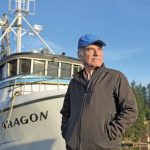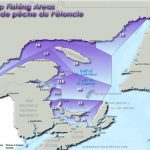Tag Archives: sockeye salmon

PWS, Cook Inlet sockeye catch exceeded harvest projections
As the sockeye salmon harvest season comes to a close, only Bristol Bay, Prince William Sound and Cook Inlet surpassed their pre-season predictions, with harvests of 31.1 million, 3.1 million and 2 million reds respectively. Cook Inlet and Prince William Sound were also the only two regions to show year-over-year growth and exceeding harvest projections, says Simon Marks, a research analyst for McKinley Research Group in Juneau, who writes the weekly in-season commercial wild Alaska salmon report on behalf of the Alaska Seafood Marketing Institute. While Bristol Bay has already surpassed the pre-season sockeye prediction by 19%, year-to-date harvest remains 23% behind 2023, Marks said on Aug. 27. Initial predictions for the 2025 season indicate an expected harvest of 32.4 million fish, a 2.8% gain if realized. more, >>CLICK TO READ<< 16:26
Bailouts
 The Alaska Congressional delegation is singing praises for a new $100 million bailout of the state’s floundering commercial salmon processing business. In a joint statement from the office of Sen. Lisa Murkowski, the trio applauded the U.S. Department of Agriculture (USDA) move with the state’s senior Republican lawmaker tried to spin it as a new poverty program to provide “almost $100 million of Alaskan seafood for people experiencing food insecurity. “This purchase won’t just bolster Alaska’s seafood industry and support our coastal communities,” Murkowski was quoted as saying, “but will help bring the highest-quality and healthiest seafood products in the world to families in need. I am grateful for the USDA’s investment in our fishermen and the health of Americans.” There has been no actual “investment in our fishermen,” presuming she is talking about Alaska fishermen. But they may benefit from a deal that helps processors clean out some of their inventory before the upcoming fishing season. More, >>click to read<< 13:06
The Alaska Congressional delegation is singing praises for a new $100 million bailout of the state’s floundering commercial salmon processing business. In a joint statement from the office of Sen. Lisa Murkowski, the trio applauded the U.S. Department of Agriculture (USDA) move with the state’s senior Republican lawmaker tried to spin it as a new poverty program to provide “almost $100 million of Alaskan seafood for people experiencing food insecurity. “This purchase won’t just bolster Alaska’s seafood industry and support our coastal communities,” Murkowski was quoted as saying, “but will help bring the highest-quality and healthiest seafood products in the world to families in need. I am grateful for the USDA’s investment in our fishermen and the health of Americans.” There has been no actual “investment in our fishermen,” presuming she is talking about Alaska fishermen. But they may benefit from a deal that helps processors clean out some of their inventory before the upcoming fishing season. More, >>click to read<< 13:06

Bristol Bay fishermen protest processors’ low sockeye market price — 50 cents per pound
Some Bristol Bay fishermen are furious over the 50 cent per pound market price for sockeye salmon that Bristol Bay processors are hitting them with. Now the fishermen are protesting over a market price they received 40 years ago — a price some fisherman said could force the industry into a downward spiral, and that action needs to be taken. On Thursday morning more than 60 fishing vessels lined the Naknek River in solidarity. Protest spokesperson Cheyne Blough said the protest was announced on Facebook when the processors declared the base price earlier this week. Blough said the 50 cent per pound market price isn’t enough for fishermen to recover their costs, and could put some out of business. Video, >click to read< 07:45

Alaskans poaching Canadian salmon top concern for federal fisheries minister
American fishing boats catching threatened Canadian salmon was flagged as a top concern for federal Fisheries Minister Joyce Murray before meeting with the U.S. ambassador to Canada in March. Over the past decade, and especially in 2021 — commercial fisheries in southeast Alaska have intercepted high numbers of Canadian salmon, particularly threatened sockeye stocks from the Nass, Skeena and Fraser rivers in B.C., the document said. The long-term rebuilding of threatened Pacific salmon stocks is a key objective for Canada, which is concerned about the potential impact a number of Alaskan fisheries are having on those stocks, the document said. >click to read< 10:47
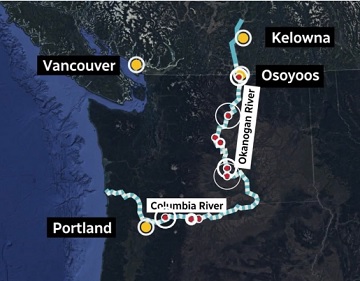
Okanagan First Nation fishery celebrates record return of sockeye salmon
An estimated 670,000 sockeye have entered the Columbia River system this summer on a nearly-1,000-kilometre upstream journey toward spawning grounds in creeks and rivers, according to fish biologists with the ONA. More than 80 per cent of those fish are destined for Canadian waters near Osoyoos, B.C., in the south Okanagan, said Richard Bussanich, the organization’s head fish biologist. “This is a great story,” Bussanich said. “We’ve got more fish than spawning habitat coming back.” In partnership with Canadian and U.S. agencies, First Nations in the Okanagan have worked to restore the migration channels and re-introduce sockeye to the region over the past two decades, each year expanding spawning territory further into the valleys’ creeks and rivers. >click to read< 11:47

B.C. fishermen fume as their Americans counterparts fish
Commercial salmon fishers and environmentalists are crying foul, for opposite reasons after U.S. fisheries officials let American fishers hit the water while the Canadian government kept their counterparts ashore. After several years of historically low runs, the Pacific Salmon Commission (PSC), an international fisheries management organization, estimated last week that enough sockeye, about 4.4 million, would return to the Fraser River to support a commercial fishery. American fisheries managers adopted the commission’s estimate, opening a small commercial fishing window over the weekend. But in a rare disagreement, Canadian officials did not, citing concerns the run would be nearly one million fish smaller than predicted, and kept Canada’s waters closed. >click to read< 10:16
Concern for BC sockeye salmon as return estimates drop by millions – The Pacific Salmon Commission’s pre-season estimate of 9.8 million returning fish went down to 5.5 million Monday, prompting environmentalists and fishers alike to express concern. >click to read<

Commercial fishers and wild salmon advocates celebrate large returns to B.C. waters
Mitch Dudoward has worked in the salmon industry for more than 40 years and says fishing on the Skeena River in northwest B.C. has never been better. “This is the best season I can recall in my lifetime with the numbers we are catching,” said Dudoward, who recently completed a big sockeye haul aboard his gillnetter Irenda. Meanwhile, Bob Chamberlin, chairman of the First Nations Wild Salmon Alliance, said thousands of pink salmon are in Central Coast rivers after years of minimal returns. The strong run comes two years after the closure of two open-net Atlantic salmon farms in the area. “We got them removed and two years later we went from 200 fish in the river to where we have several thousand to date. In our mind and knowledge that is a really clear indicator.” >click to read< 10:41

Strong sockeye salmon runs bode well for famed Fraser fishery
“The last bunch of years have just been nothing but doom and gloom when it comes to B.C. salmon,” said Granville-Island based fisher Steve Johansen, who just returned from “crazy” commercial fishing in Barkley Sound a week ago where sockeye returns were more than double Department of Fisheries and Oceans estimates. On the Skeena River, a key B.C. salmon river, returns have been 50 per cent higher than estimates. “I think everything else (that has) happened this summer before the Fraser runs is just making everybody’s anticipation and excitement just up a couple more notches,” Johansen said. >click to read< 12:50

B.C. groups call on Alaska to halt interception of Canadian salmon
In a letter addressed to Alaska Gov. Mike Dunleavy, four salmon conservation groups presented data indicating that in 2021 more than 650,000 Canadian-origin sockeye salmon were caught in the waters of southeast Alaska. That is six times the 110,000 sockeye B.C. commercial fishers caught last year. “We’re just talking about the fish we know that are getting killed up there,” said Greg Taylor, a longtime consultant with commercial and First Nations fisheries. B.C. salmon populations have plummeted to record lows in recent years. In response, the federal government closed 60 per cent of B.C.’s commercial salmon harvest in June 2021 and announced a fishing licence buy-back program under its $647-million Pacific Salmon Strategy Initiative. The result for B.C., says Taylor: “It makes us a spawning ground for Alaska.” >click to read< 13:12

Boom-bust commercial salmon season doubles 2020 value
This summer was significantly better for commercial salmon fishermen in Alaska than 2020, though that success was far from evenly spread. Commercial salmon fishermen hauled in salmon valued at $643.9 million this season, according to the Alaska Department of Fish and Game. That’s more than double the 2020 value of $295.2 million, but still a little behind the estimated 2019 value of $657.6 million. Overall, 2021 ranks fairly well in the historical averages for numbers of salmon harvested and poundage as well as in value, according to Fish and Game data. >click to read< 16:37

One Alaska Bay Is Booming With Salmon, For Now
Bristol Bay’s sockeye harvest has long made up about half of the global catch of this species, in a seasonal blitz as short as it is enormous: The fishery lasts a mere six weeks. Each summer, 15,000 seafood processors, boat-based fishermen, and setnetters, including families such as the Bandles, gather here to support an industry worth more than $2 billion in 2019. Some fishermen will net enough cash to live on until the fish come back the next year. And this year, Bristol Bay outdid itself,,, But such riches are localized. Outside of Bristol Bay, salmon fisheries are failing, including those on British Columbia’s famed Fraser River, on Alaska’s Chignik and Copper Rivers, and in Cook Inlet. Five hundred miles north of Bristol Bay, Yukon River salmon runs have totally collapsed. >click to read< 12:35 ADFG: Bristol Bay sockeye runs set all-time record – It’s official: Bristol Bay’s 2021 commercial salmon season was the largest on record. >click to read<

When Sailboats Ruled Bristol Bay
One hundred and thirty-two years ago, the Bristol Bay commercial fishery began on the shores of the Nushagak River when the first cannery went into operation and canned a little more than 4,000 salmon. Within four years, three more canneries appeared on the Nushagak, and within a decade canneries were built on the Naknek and Kvichak rivers. The dawn of the 20th century saw dozens of canneries around Bristol Bay catching, processing and canning millions of pounds of sockeye salmon every summer. By 1910, Bristol Bay accounted for 40 percent of Alaska’s commercially caught salmon. Even today, Bristol Bay makes up about 40 percent of Alaska’s salmon value. photo’s, >click to read< 11:50

“We’ve been sitting on the beach for 16 days” – Copper River salmon fishery reopens
“We are back to getting into the goal range,” said Jeremy Botz, finfish area management biologist for the Alaska Department of Fish and Game in Cordova. “I think we are seeing a late compressed run. I still feel it is a relatively small run, but higher than in 2018 and 2020.”,, While eager to be fishing again, veteran Cordova harvesters felt they should have been allowed out on the grounds earlier to get a better handle on what the run, albeit late and maybe compressed, was really stacking up to be.,, Cordova harvester John Renner said the fleet should have been used earlier to collect data, to see if the run was weak or strong, rather than just waiting for the sonar count. “We’ve been sitting on the beach for 16 days,” >click to read< 14:15

Canada’s sockeye salmon find their way home again after 50 years
For the first time in over 50 years, spawning sockeye salmon will return to Okanagan Lake in British Columbia,,, A fish ladder, left inoperable after the Penticton Dam was built in the 1950s, has been restored by the Okanagan Nation Alliance and Fisheries and Oceans Canada. A crane was used to remove a wooden gate blocking off the narrow concrete passage, opening the way for fish to get through. “To watch that gate go up, and to know that fish can finally return to their historic grounds, was a tearful moment,” she said. McFayden is a member of the Okanagan River Restoration Initiative (ORRI) and the Okanagan Similkameen Conservation Alliance. >click to read< 07:55
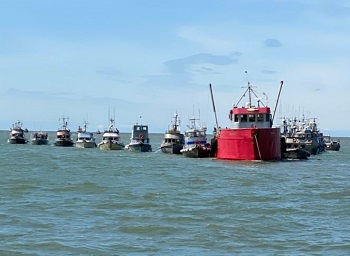
2020 commercial salmon catch, and value took a dive
Commercial salmon harvests proved challenging for the 2020 season, challenged by a global pandemic of the novel coronavirus, with the overall fish catch and its value down considerably from a year earlier. Data released on Monday, Nov. 9 by the Alaska Department of Fish and Game, said the all species harvest has an approximate value of $295.2 million, down 56 percent from $673.4 million in 2019. Fishermen delivered some 116.8 million fish, a 44 percent drop from the 208.3 harvested a year earlier, the report said. >click to read< 18:15

Minnesota family spends summers fishing Alaskan salmon to sell back home
The Rogotzkes, brothers Jay and Tom, dad Roger and uncle Dave, all run their own boats in Bristol Bay, home to the world’s largest sockeye salmon run. The Rogotzkes fish in 32-foot aluminum boats that drift freely, even with 900 feet of net trailing. It was Roger who got the family started in the unlikely profession more than 40 years ago. Back in college in 1980, Roger read about Bristol Bay in a magazine. Intrigued, he bought himself a plane ticket north the next summer. Two years later, in what the Rogotzkes now recognize as an astounding act of faith, Roger’s dad, Bob, mortgaged the family farm in Minnesota to buy his son a fishing boat and permit. That investment paid off, and two years later Bob did the same thing for his other son, Dave. “We really just owe everything to him,” Roger said. That makes this season bittersweet: Bob died in May, just before the four fishermen headed north. >click to read< 18:12

Fraser River sockeye fishery could be shut down for years
Fraser River sockeye, once the bread-and-butter of the commercial sector, appear to be collapsing for real this time. In 2009, low returns were described as a collapse, but the next year, Fraser River sockeye staged a major comeback, with 28 million fish returning, followed by 19 million in 2014. The Pacific Salmon Commission (PSC) estimates that only 283,000 sockeye may return to the Fraser River this year – a fraction of the 941,000 in a pre-season forecast, and only one-quarter of what is needed to meet this year’s escapement target. >click to read< 10:18

Alaska and B.C.’s salmon runs expected to be worst ever recorded
Salmon returns on the west coast look bleak this year. Alaska’s salmon returns have been so poor that some communities already are claiming fishery disasters. The socket salmon run on B.C.’s Fraser River is expected to be the worst ever recorded,, in Alaska, the Cordova City Council passed a resolution last week, asking the state to declare disasters for both the 2018 Copper River sockeye and chinook salmon runs and the 2020 sockeye, chum and chinook runs at the Copper River and Prince William Sound,, The Pacific Salmon Commission (PSC) says this year may turn out to be the worst for sockeye salmon in the Fraser River since tracking began in 1893, >click to read< 12:56

Third time was the charm
Light winds, fog and rain spread over Prince William Sound on the eve of a 12-hour Memorial Day fishery, then turned overcast during the holiday, as the commercial fishing crews netted some 1,467 Chinook and 33,752 sockeye salmon. The catch boosted the total harvest to date to an estimated 45,537 fish, including 4,935 kings and 39,823 red salmon, well over five times the individual catches on May 14 and May 18. The first two 12-hour openers were so slow that the Alaska Department of Fish and Game cancelled fishing for the third opener on May 21. Now the fishery appears to be picking up speed. “It’s still not good,” said veteran harvester Jerry McCune,“We’re getting further behind every day. Hopefully things will pick up in June.” >click to read< 17:15

Sockeye harvest breaks all-time top 5; pinks picking up
The 2019 salmon season has seen plenty of fish return to the state, but far from evenly across regions. As of Sept. 10, commercial fishermen across Alaska have landed 198.4 million salmon of all five species, about 8 percent less than the preseason forecast of 213.2 million. Most of that shortfall is in pink and chum salmon, which haven’t delivered on their forecasts so far, but a surplus of sockeye salmon helped make up for some of that gap. Statewide, commercial fishermen have landed more than 55.1 million sockeye, about 9 percent more than last year and 5 million more than the preseason forecast. >click to read< 07:40

Cook Inlet salmon fisheries into full swing after rough 2018
Upper Cook Inlet salmon fisheries are now in full swing, with promising sockeye returns finally showing up. East Side setnetters in the sections north of Kasilof opened for their first period July 8, and the personal-use dipnet fishery on the Kenai River opened July 10. They join the drift gillnet fleet and other Upper Cook Inlet setnetters as well as the inriver sportfishery and the Kasilof River personal-use fishery. As of July 8, nearly 80,000 sockeye salmon had passed the sonar in the Kenai River. That’s more than double the number that had passed through on the previous date in 2018, when only 37,513 had passed, according to the Alaska Departm,,, >click to read< 15:31

Bristol Bay – Why the two main forecasts have a 5 million-fish difference
This year, 44.6 million sockeye salmon will return to Bristol Bay – if you trust the University of Washington forecast. But the University of Washington forecast isn’t the only one out there. “This year’s forecast is 40.18 million,” said Gregory Buck, Fish and Game’s fishery biologist and regional research coordinator for Bristol Bay. Buck says the almost 5 million sockeye difference between the ADF&G and UW forecasts has a pretty simple explanation: an accumulation of small data interpretation differences. >click to read< 10:31

Monterey Bay fishermen catch salmon as far away as Alaska. A proposed copper mine there poses a local threat.
Tom DiMaggio is 96 years old and blessed with a full head neatly combed white hair and a warm handshake. A fisherman for his whole career, he’s been retired for over 20 years and remains a vibrant member of the fishing community – only these days, the community is far from the dock and instead gathers at the East Village Coffee Lounge in Monterey to while away weekday mornings, sipping espresso and swapping stories.,,Commercial fishing is an unpredictable profession in many ways, though the two greatest uncertainties are how many fish are caught and how much those fish sell for. The nature of the job means many fishermen want to surround themselves with a crew they can trust, which often means family. Ask the East Village table of old-school fishermen how they got started, and they all have a similar answer:, >click to read<14:00
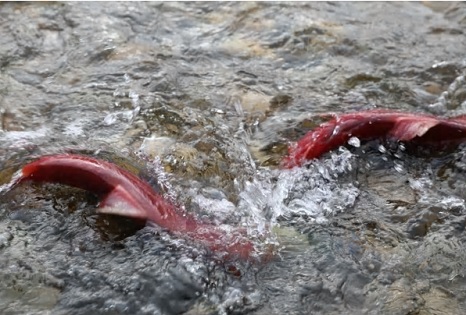
Fisheries official says 2018 saw a ‘reasonably good return’ despite low numbers
The number of sockeye salmon that made it up the Fraser River last fall was lower than originally predicted, prompting a conservation group to blame the federal fisheries regulator for allowing the area to be overfished. “This year, it was the lowest run or spawning return they’ve seen on record on this cycle,” Greg Taylor told CBC Radio’s Daybreak Kamloops host Shelley Joyce. “They were very disappointing,” said Taylor, a senior fisheries advisor for the Watershed Watch Salmon Society.,,, A DFO representative told Joyce on Thursday that, while the numbers were lower than predicted, the return numbers were not out of the ordinary >click to read<20:14
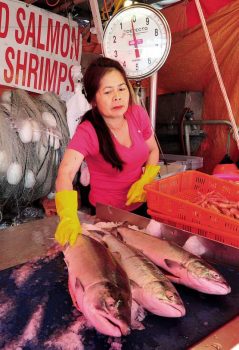
Fraser River sockeye finally catch a break with cooling water temps
Sockeye salmon entering the Fraser River this week will be aided by cooling water temperatures, which should decrease mortality and help them reach their spawning grounds up river in better condition. Commercial fishers are optimistic that the sockeye run will live up to early season predictions as late-season fish start to enter the river. Sockeye migrating into the river this summer are the grandchildren of the record-breaking 2010 run that exceeded 28 million fish. “The fishing we’ve had up to this point has been pretty darn good,” said Chauvel. “You have to make your money in these peak years. The years in between are subsistence, so it’s these sockeye years that put you over the top.” >click to read<22:02

Alaska’s 2018 commercial salmon harvest 30 percent below forecast, yet some fisheries have boomed
The statewide commercial salmon harvest is about 31 percent below the preseason forecast, the Alaska Department of Fish and Game said in a statement Thursday. The 2018 season, it said, “has been unusual.” Preliminary numbers show a statewide commercial salmon harvest of about 103 million fish so far. That’s subject to change, because the fishing season isn’t completely over yet. Fish and Game’s forecast in March projected a total statewide harvest of 147 million fish. >click to read<08:03

The mysterious case of Alaska’s strange sockeye salmon returns this year
There’s something unusual going on with the sockeye salmon runs returning to Alaska this year. In some places — like Bristol Bay — the runs are strong. In others, like the Copper River or the Kenai River they’re unexpectedly weak. In some places, there are sockeye that are unusually small. In others, sockeye of a certain age appear to be missing entirely. It’s a mystery. In Southeast Alaska, one of the first Fish and Game staffers to notice an unusual trend was Iris Frank, a regional data coordinator and fisheries technician. Frank’s lab is on the first floor of Fish and Game’s Douglas Island office that looks like it hasn’t changed much in the 32 years since she got there. >click to read<18:06














































